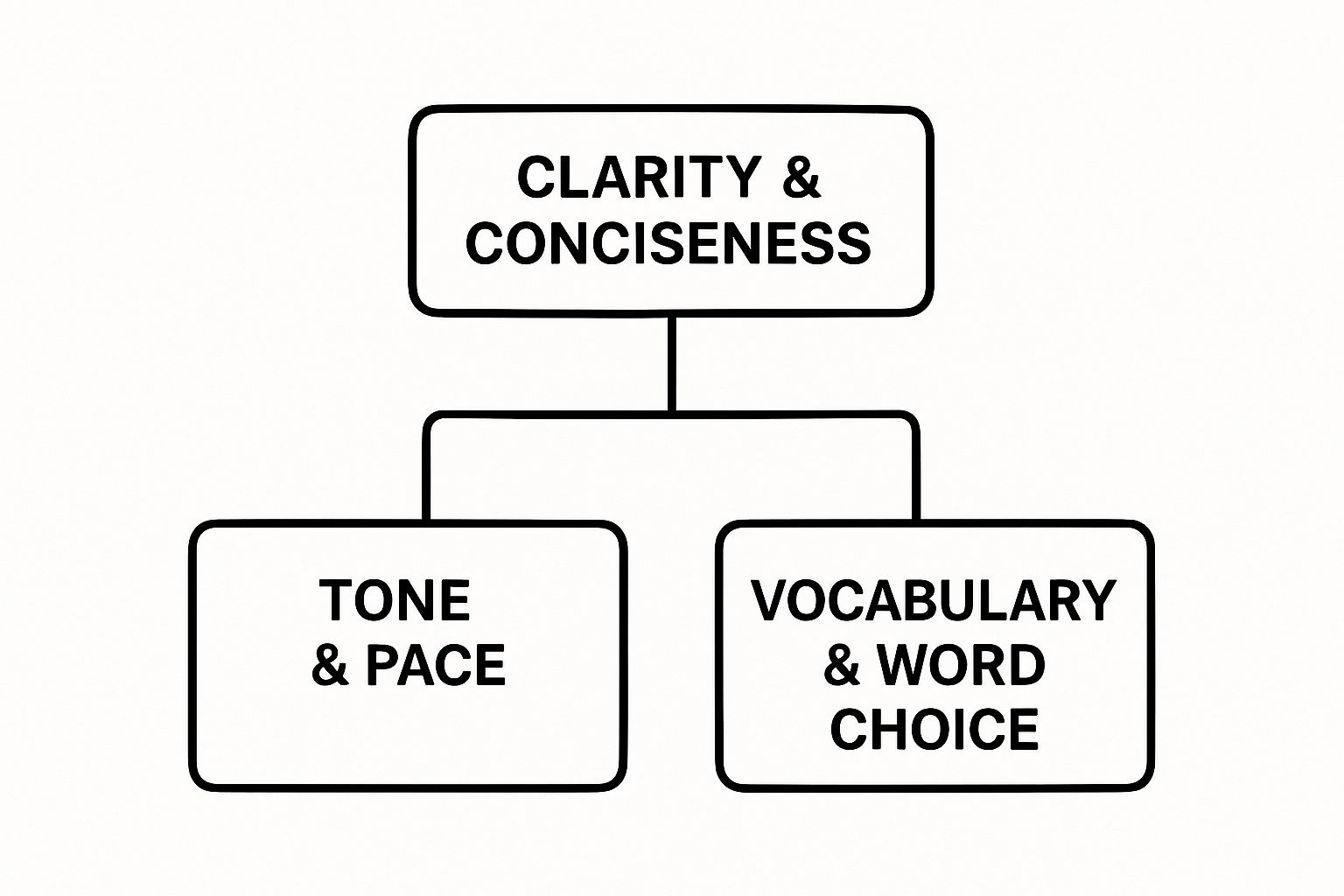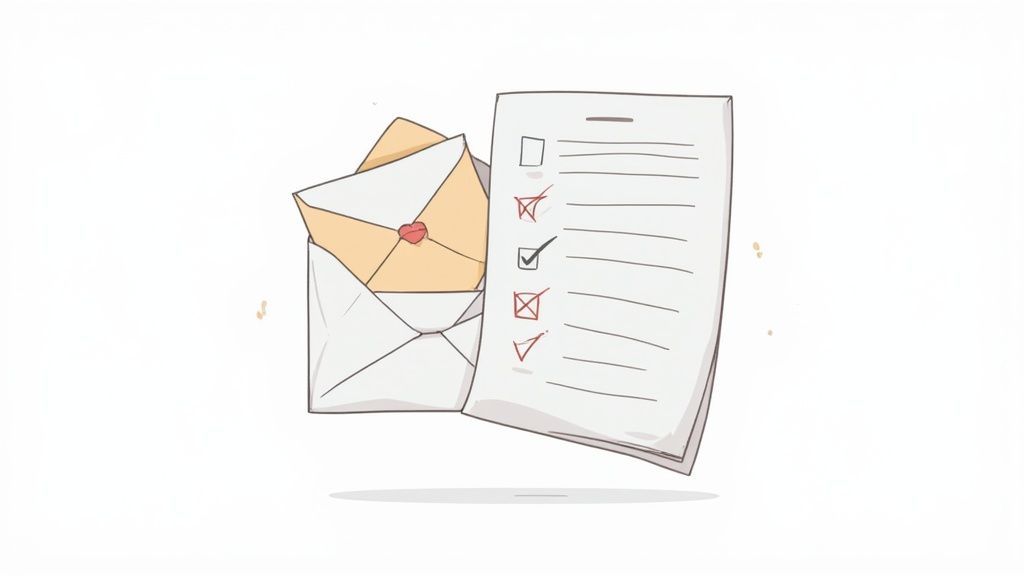Enhance Your Career with Business Communication Skills

In any job, business communication skills are what turn ideas into reality. They’re how we build relationships, get things done, and ultimately, drive results. It's best not to think of them as optional "soft skills," but as the basic operating system for your entire career. They touch everything, from day-to-day chats with coworkers to your long-term growth.
Why Business Communication Is Your Ultimate Career Skill

Think of your career like a high-performance engine. Your technical talents—coding, design, analysis—are all the crucial parts. But business communication skills are the oil that keeps everything running smoothly, preventing friction and letting you hit top speed.
Without good communication, even the most brilliant plans fall apart. Projects get stuck, teams get out of sync, and great ideas simply get lost. That's why getting this right isn't just a nice-to-have; it's a non-negotiable for anyone who wants to succeed.
The Foundation of Workplace Success
When you get down to it, solid communication is the fuel for almost every good thing that happens at work. When messages are clear, concise, and delivered with a bit of empathy, teams just move faster and more accurately. This clarity builds the bedrock of a healthy workplace:
- Better Team Cohesion: Clear talk cuts down on confusion and helps build a real sense of collaboration. It lets people work with each other, not just alongside each other.
- Faster Project Timelines: When everyone knows exactly what they’re supposed to do, projects move forward without all the unnecessary delays and rework.
- Stronger Client Trust: The ability to explain value, set expectations, and actually listen to feedback is what builds client relationships that last.
- Greater Leadership Potential: What defines a leader? Their ability to inspire, persuade, and guide. All of that comes down to world-class communication.
The proof is in what employers are looking for. Projections show that 57% of global employers see communication as the single most desirable skill for new hires in 2025. On the flip side, a massive 86% of employees and executives say that most workplace failures boil down to a lack of collaboration and communication.
"Communication is the real work of leadership. It’s the essential tool for building relationships, inspiring action, and creating a shared sense of purpose."
From Skill to Strategy
At the end of the day, powerful communication is what separates the good professionals from the great ones. It shapes how your colleagues and bosses see you, which has a direct line to how your career unfolds. For leaders, this is deeply connected to their professional reputation, something we dive into in our guide on personal branding for executives.
If you really want to unlock your potential, you have to master essential business communication skills. Putting in the effort here is a direct investment in your own value, turning you from someone who just contributes into someone who truly influences and becomes indispensable to any team.
The Four Core Channels of Workplace Communication
Think of your communication skills like a master craftsman's toolkit. You wouldn't use a sledgehammer for delicate woodwork, right? The same logic applies at work. To get your message across with real impact, you need to know which tool—or channel—to pull out for the job.
The four core channels are verbal, non-verbal, written, and digital. Each has its own strengths and weaknesses. A quick phone call can clear up confusion in seconds, saving you from a long, drawn-out email chain. A confident posture during a presentation can sell an idea more effectively than the words on your slides. Let's dig into each of these and see how to use them like a pro.
Mastering Verbal Communication
Verbal communication is what happens face-to-face, on the phone, or in a meeting. It’s the most direct and personal way we connect with colleagues and clients. The real goal here isn’t just to talk, but to be truly understood.
Effective verbal skills are about more than just a good vocabulary. It’s about being direct and cutting out those pesky filler words—like "um," "like," or "you know"—that can subtly chip away at your credibility. Here’s a simple but powerful trick: when asked a question, take a beat. A short pause makes you seem thoughtful and gives you a moment to frame a much stronger response.
The infographic below shows how the different layers of verbal communication build on each other.

As you can see, controlling your tone and pace is the foundation. Only then can your choice of words lead to true clarity.
The Power of Non-Verbal Cues
Often, what you don’t say speaks the loudest. Non-verbal communication is all about your body language, facial expressions, eye contact, and posture. These cues are constantly broadcasting messages, either backing up your words or completely undermining them.
Picture a team meeting. If you’re leaning in, making eye contact, and nodding along, you’re sending a clear signal: "I'm engaged and I value what you're saying." But if you're slumped in your chair, arms crossed, glancing at your phone? You're screaming disinterest, no matter how polite your words are.
Being aware of non-verbal signals—both yours and those of others—is a huge part of emotional intelligence. It’s how you read the room, adapt on the fly, and build genuine rapport.
Here are a few simple ways to sharpen your non-verbal game:
- Keep an Open Posture: Avoid crossing your arms. Face the person you're speaking with to appear more approachable and open to their ideas.
- Show You're Listening: A simple nod or consistent eye contact tells the speaker you're tuned in and that their perspective matters.
- Mirror Positive Body Language: If you subtly mirror the positive posture of the person you're talking to, it can create a subconscious sense of connection.
Excelling in Written Communication
In most modern offices, written communication reigns supreme. We live in a world of emails, reports, Slack messages, and project briefs. Your ability to write with clarity and professionalism is always on full display.
The tricky part? Written words lack the context of tone or body language. A well-written email can spur a team into action, but a sloppy one creates confusion and kills momentum. The key is to be direct, professional, and always write with your reader in mind.
For example, always use a specific subject line. Instead of a vague "Meeting Follow-up," try "Action Items from 10/26 Project Kickoff." It’s a small change that makes a huge difference.
These principles of clarity extend beyond email. To make your ideas land with authority in more formal settings, it helps to learn how to improve presentation skills, as the logic behind a great presentation often mirrors that of a persuasive document.
Navigating the Digital Channels
The final piece of the puzzle is digital communication. This covers all the modern tools we rely on, from instant messengers like Slack and Microsoft Teams to video platforms like Zoom. These tools are fantastic for speed and convenience, but they come with their own unwritten rules.
Digital communication can be a minefield because it blurs the line between formal and informal. A Slack message should be quick and to the point. A video call demands the same non-verbal awareness as an in-person meeting. The challenge is knowing which tool is right for the situation.
You wouldn't try to resolve a sensitive team issue over instant messenger; that needs the nuance of a phone or video call. But a quick question about a deadline? That’s perfect for Slack, and it keeps everyone's inbox a little cleaner. Getting these digital skills right means picking the right tool for the job to make work smoother, not more complicated.
To bring it all together, here’s a quick summary of these four pillars.
Four Pillars of Business Communication
| Communication Type | Primary Channels | Essential Skill to Master |
|---|---|---|
| Verbal | Meetings, phone calls, presentations | Clarity and conciseness |
| Non-Verbal | Body language, eye contact, posture | Reading the room |
| Written | Emails, reports, instant messages | Brevity and directness |
| Digital | Video calls, messaging apps, social media | Choosing the right tool for the task |
Mastering each of these areas—and knowing how they work together—is what separates good communicators from great ones.
The Real Cost of Poor Communication

We've all been there. The vague email, the meeting that goes nowhere, the instructions that everyone interprets differently. These moments feel like minor annoyances, but they're not. They're a silent tax on your entire organization.
Poor communication quietly drains resources, stifles good ideas, and creates friction where there should be smooth collaboration. Each little breakdown might seem insignificant on its own, but they pile up. Before you know it, you're dealing with an environment of confusion and inefficiency that can bring even the most talented teams to a screeching halt.
Quantifying the Damage
It’s easy to feel the frustration of a project gone wrong, but the financial toll is often invisible—and staggering. When messages get crossed, your team isn't moving forward. They're spending valuable time and energy fixing mistakes that never should have happened.
The numbers are genuinely startling. In the United States alone, companies lose an estimated $1.2 trillion every year due to ineffective workplace communication. That breaks down to an average cost of $12,506 per employee, per year. If you're curious about the data behind this, a great workplace communication statistics report breaks it all down.
This isn't just some abstract economic figure; it’s a real, tangible loss. It’s the price of duplicated work, failed projects, and employees who have simply checked out. It also fuels some of the most persistent problems any business can face:
- Sinking Morale and Engagement: Constant confusion leaves employees feeling frustrated and undervalued. Why give your all when your efforts are wasted?
- Higher Employee Turnover: A toxic communication culture is one of the top reasons great people quit. This forces you back into the expensive cycle of hiring and training.
- Damaged Client Relationships: Miscommunication with clients leads to missed expectations and broken trust. Suddenly, knowing how to handle customer complaints becomes a critical damage-control skill, not a growth strategy.
Poor communication is the number one source of preventable problems in any organization. It transforms simple tasks into complex challenges and turns alignment into opposition.
A Project Derailed by a Simple Email
Let's walk through a scenario that plays out in businesses every single day.
A project manager shoots off an email to their design and development teams: "Let's get the new feature prototype ready for the client meeting next week. We need to show them our progress."
The designer reads "prototype" and immediately thinks of high-fidelity, polished mockups. They spend three days perfecting every pixel. At the same time, the developer sees "prototype" and starts building a basic, functional wireframe—something clickable, but visually simple.
They both show up to the pre-meeting sync, proud of the days of work they’ve put in, only to realize their efforts are completely misaligned. Neither version is what the project manager actually needed, which was a semi-functional model to showcase one specific user workflow.
The result? Wasted time, a frantic scramble before the client meeting, and a team feeling defeated and stressed. This single, vague email cascaded into budget overruns and a damaged team dynamic, all because of a simple failure in business communication skills.
How Modern Work Rewrote the Communication Rules

Let's be honest: the old office communication playbook is gathering dust on a shelf somewhere. Gone are the days when you could rely on a quick chat in the hallway or a weekly in-person meeting to keep everyone on the same page.
Today, we're navigating a much more complex world of digital tools and scattered teams. This shift has completely changed how we connect, collaborate, and even build trust with our colleagues. With the rise of remote work and hybrid models, the old rules just don't cut it anymore.
We're now up against new challenges that require a far more intentional approach to our business communication skills. "Zoom fatigue" is a real thing, and building a genuine connection through a screen takes a different kind of effort than a simple handshake. This new environment demands that we not only get comfortable with digital tools but also understand exactly when and how to use them.
The Digital-First Mindset is Here to Stay
The pandemic was the catalyst, but the move toward digital collaboration was already in motion. Now, even with some people back in the office, the digital-first way of thinking has stuck. Remote work is still a massive part of the professional world—a full 42% of workers are still doing their jobs from home.
Email remains a heavyweight champion, used by 36% of employees for internal updates and 55% for talking to clients. These numbers, detailed in this communication statistics report, tell a clear story: how well we communicate through a screen directly impacts how well we do our jobs.
Of course, this reliance on digital channels brings its own set of problems. Without the immediate feedback of a smile or a nod, messages can easily get twisted, leading to misunderstandings that kill momentum.
In a remote or hybrid world, clarity isn't just nice to have; it's a survival skill. Every single message has to be crafted with purpose to close the physical gap between team members.
Synchronous vs. Asynchronous: Finding Your Rhythm
To really nail communication today, you need to understand the two different cadences of work talk: synchronous and asynchronous. Knowing which one to use in any given situation is the secret to getting things done without burning out your team.
Synchronous communication is the stuff that happens in real-time. It’s the immediate back-and-forth of a video call or a live brainstorming session.
- Examples: Video conferences, phone calls, in-person meetings.
- Best for: hashing out complex problems, making urgent decisions, and having sensitive conversations where you need to read the room.
Asynchronous communication, on the other hand, has a built-in delay. Think of sending an email or dropping a comment in a project management tool. You send your message, and the other person responds when they can. This is the absolute backbone of deep, focused work for any distributed team.
- Examples: Emails, updates in tools like Asana or Trello, recorded video messages.
- Best for: Non-urgent updates, sharing info that needs a paper trail, and giving people in different time zones a chance to contribute without feeling pressured to be online 24/7.
Adapting Your Skills for This New Workplace
You can't just show up and expect communication to work like it used to. Thriving today means actively adapting your habits. It's not enough to just fire off a message; you have to make sure it lands exactly as you intended.
First, be ridiculously clear in your writing. Since it's so easy for your tone to be misread, use formatting like bold text and bullet points to guide the reader's eye and add emphasis. A well-structured email is worlds better than a giant wall of text.
Next, become a master of your collaboration tools. Know when a quick Slack message will do the trick and when you need to schedule a proper video call. Using the right tool for the job cuts down on digital clutter and helps everyone stay focused.
Finally, you have to be intentional about building connections. The casual coffee machine chats don't just happen anymore. Make time for brief, informal video check-ins or create chat channels just for non-work stuff. These small efforts are what keep the team culture alive and maintain the personal bonds that great collaboration is built on.
Actionable Strategies to Improve Your Communication Skills
Knowing the theory is one thing, but putting it into practice is where you’ll actually see results. The real growth happens when you move from just understanding a concept to using it in your day-to-day interactions. This is your toolkit for making that happen.
Below are a few practical, step-by-step strategies you can use to sharpen your professional communication. Think of these less as abstract ideas and more as mini-tutorials you can start applying today to see a real difference in your meetings, emails, and conversations.
Structure Your Stories with the STAR Method
Whether you’re in a job interview, pitching a client, or updating your team, storytelling is an incredibly powerful tool. A good story makes your points stick and persuades people in a way that dry facts just can't. The STAR method is a simple but brilliant framework for structuring those stories with clarity and impact.
It creates a logical flow that walks your listener from the initial challenge straight through to the successful outcome, proving your skills along the way.
Here’s how you break it down:
- Situation: First, set the scene. Briefly describe the context you were in. (e.g., "Our team was staring down a tight deadline for a major client project.")
- Task: Next, explain your specific role or what you were trying to achieve. (e.g., "It was my job to figure out how to streamline our data analysis process to save time.")
- Action: This is the core of the story. Detail the specific steps you took. This is where you really highlight your skills and initiative. (e.g., "I built a new spreadsheet template with automated formulas that completely cut out manual data entry.")
- Result: Finally, wrap it up with the outcome. Use numbers whenever you can to show the impact. (e.g., "Because of that, we cut our analysis time by 40% and delivered the project two days ahead of schedule.")
Using this structure keeps your anecdotes concise, relevant, and powerful. It’s an indispensable tool for showing your value, not just talking about it.
Become a Master of Active Listening
Communication is supposed to be a two-way street, but let's be honest—we often spend more time planning what we're going to say next than actually hearing what the other person is saying right now. Active listening is about making a conscious effort to hear the complete message, not just the words.
It’s about genuine understanding, not just waiting for your turn to talk. When you truly listen, you make the other person feel heard and respected, which is the bedrock of trust.
"The most basic of all human needs is the need to understand and be understood. The best way to understand people is to listen to them."
To start practicing this, focus on these two techniques:
Paraphrasing for Clarity: After someone shares an idea, repeat it back to them in your own words. You can kick it off with something like, "So, if I'm getting this right, you're saying that..." or "It sounds like the main issue is..." This simple step confirms you're on the same page and gives them a chance to correct you if you're not.
Asking Powerful Questions: Don't just be a passive receiver of information—dig a little deeper. Ask open-ended questions that invite more than a "yes" or "no." Try things like, "Can you walk me through how you got to that conclusion?" or "What do you see as the biggest challenge if we go that route?" This shows you’re not just hearing, but actively thinking about what's being said.
Write Emails That Actually Get a Response
Your inbox is a constant battle for attention. If you want your messages to be read and acted upon, you have to write emails that are clear, direct, and respectful of the other person's time. A sloppy, confusing email just creates more work for the reader and can bring important decisions to a grinding halt.
Try using this simple framework for every email you send:
- Start with a Specific Subject Line: Ditch vague subjects like "Question" or "Update." Be specific so they know exactly what's inside: "Feedback Needed on Q3 Marketing Draft by EOD" tells them everything they need to know.
- State Your Purpose Immediately: Get right to the point in the very first sentence. "I'm writing to request your approval on the attached budget proposal." No need for a long wind-up.
- Use Formatting for Readability: Break up your text. Use bullet points or numbered lists for key information or action items. This makes your message scannable and way easier to digest.
- End with a Clear Call to Action: Don't leave them guessing what you need from them. End your email with a clear next step. For example, "Please review the document and send your feedback by 3 PM tomorrow."
Give and Receive Feedback for Growth
Feedback is the fuel for professional development, but it can be incredibly awkward to both give and receive. The key is to turn these potentially tricky conversations into positive moments for growth.
When delivering constructive feedback, get specific and focus on the behavior, not the person. Instead of saying, "You're not engaged in meetings," try something like, "I noticed you were looking at your phone during this morning's presentation. It made it seem like the topic wasn't a priority for you." This approach feels less like an attack and opens the door for a real conversation.
When you're the one receiving feedback, your number one job is to listen with an open mind. Fight that natural urge to get defensive. Thank the person for sharing their thoughts, ask questions to make sure you fully understand their point of view, and give yourself a moment to reflect on it before you respond.
Frequently Asked Questions About Business Communication
When you're trying to master professional interaction, a lot of practical questions come up. Let's tackle some of the most common ones to help you move from theory to confident, everyday practice.
What Is the Single Most Important Business Communication Skill?
You could make a case for a dozen different skills, but most experts land on one that underpins all the others: active listening.
It’s not just about staying quiet while someone else talks. Active listening is about digging deeper—fully concentrating on the message, understanding the intent behind the words, and catching the emotional cues. When you master it, you build stronger relationships, slash misunderstandings, and can respond far more thoughtfully. It's the one skill that makes every other one—negotiating, leading, collaborating—even better.
How Can I Improve My Communication Skills in a Remote Team?
Communicating well in a remote team is all about being more intentional. You can't lean on a quick chat in the hallway or read someone's body language, so you have to create clarity on purpose.
- Over-Communicate (The Right Way): Keep everyone in the loop with frequent, clear updates on your projects and availability. It nips ambiguity in the bud and keeps the whole team aligned.
- Master Your Tools: Know when a quick Slack message will do and when a topic needs a proper video call. Using the right channel is half the battle.
- Watch Your Written Tone: Your emails and messages carry a lot of weight when there are no non-verbal cues. Make sure your tone comes across as clear, professional, and positive.
- Schedule Time for Banter: Make time for virtual coffee chats or other non-work conversations. These moments build the personal connections that really hold a team together.
If you want to get a baseline for where you stand now and pinpoint exactly where you can improve, a good communication skills assessment test can be incredibly helpful.
How Can AI Help Improve My Communication Skills?
Technology can be a fantastic coach for sharpening your professional communication. Modern tools can give you real-time feedback that helps you fine-tune your skills on the fly.
Think of it like this: AI-powered writing assistants don't just check your grammar anymore. They analyze your text for clarity, conciseness, and tone, making sure your message lands exactly the way you want it to.
There are also tools that let you practice presentations and get feedback on your pacing, your use of filler words, and your overall delivery. Some AI can even suggest simpler ways to explain complex topics or summarize long email threads to keep everyone on the same page. It's like having a communication coach on call 24/7.
Ready to turn your professional insights into visually stunning content that grabs attention? Lumeo helps you transform articles, videos, and even simple text into compelling carousels for platforms like LinkedIn and Instagram. Create engaging visuals effortlessly and build your brand. Discover how Lumeo can elevate your content at lumeo.me.